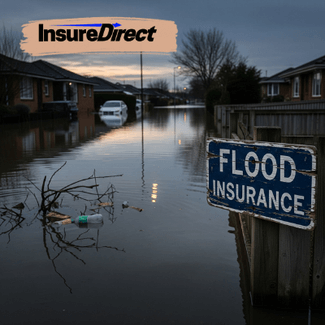I’ll be honest—until a few years back, I didn’t think twice about flood insurance. Sounded like something only folks near the coast worried about. Big mistake.
Most people don’t even know their regular home policy won’t cover flood damage. I learned that the hard way while helping a friend clean up after a “small” river overflow. A few inches of water? Yeah, that can trash a living room beyond recognition.
Why It Actually Matters
Think about this—FEMA says one single inch of water could run you $25,000 or more in repairs. And that’s just the starting point. No policy? You’re swiping the credit card or draining savings.
Floods aren’t picky. Hurricanes, thunderstorms, busted dams, snow melting too fast—pick your poison.
What’s It Gonna Cost You in 2025?
Prices are like a wild rollercoaster. On average? Somewhere between $800 and $1,500 yearly if you’re going by NFIP numbers.
High-risk flood zones—like the ones on FEMA’s scary red maps—might see $3,000 or more every year. But if you’re in one of those calmer, “low chance” areas, there’s something called a Preferred Risk Policy. That could be $300–$500 a year instead.
Stuff That Decides Your Premium (a.k.a. Why Your Neighbor Pays Less)
Where you live – FEMA has this alphabet soup of flood zones. Zones A or V? Expensive.
Elevation – If your house is sitting up higher than the flood level, premiums tend to shrink. Below it? They grow.
Coverage limits + deductible – More coverage = more money. Bigger deductible = smaller premium (but bigger “ouch” when you claim).
Private vs. NFIP – Private insurers sometimes offer juicier coverage, but they also play by their own pricing rules.
Property type – Primary homes often get cheaper rates than vacation houses.
Community discounts – Some towns earn FEMA brownie points and pass the savings to residents.
NFIP vs. Private – Who’s Better?
NFIP’s been around forever, but private companies are stealing the spotlight. NFIP caps out at $250k building + $100k contents, while private might hand you higher limits and extra perks. Some private plans even cover living expenses if your place is unlivable—NFIP doesn’t.
The catch? Private insurers can be picky about who they cover, and prices shift more than a river current.
How I Figured Out How to Pay Less
I went down the rabbit hole trying to cut my own premium. Here’s what I learned:
Jack up the deductible if you can handle the risk.
Elevate the building or critical utilities above flood levels.
Install flood vents and swap out stuff for water-resistant materials.
Check if your community offers FEMA discounts (shocking how many do).
Don’t just renew—call multiple insurers every year.
Worth It or Not?
Honestly? Yes. Even for folks in low-risk spots. My neighbor swore he didn’t need it—then a heavy rain clogged the storm drains. Basement gone, $40k in repairs, no coverage.
The premium feels small compared to the cost of rebuilding. Especially with climate change throwing more curveballs, floods aren’t “once in a lifetime” anymore.
Final Takeaway
Flood insurance costs in 2025 are all over the map—literally. Where you live, how your house is built, and who’s insuring you will make a huge difference. But whether you go NFIP or private, the point’s the same: protecting your place is cheaper than fixing it.
If you’re looking for top-quality insurance coverage, InsureDirect is your go-to choice. Getting a home insurance quote is fast and hassle-free. Simply visit our website or reach out to our corporate office:
InsureDirect.com
Corporate Home Office
618 South Broad Street
Lansdale, Pennsylvania 19446
contact@insuredirect.com
Phone: (800) 807-0762 ext. 602
Protect your home and enjoy peace of mind with the reliable insurance solutions from InsureDirect. Because your home deserves the very best.

